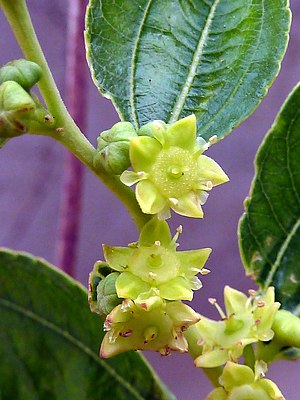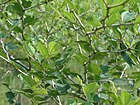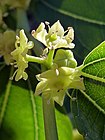Note: This is a project under development. The articles on this wiki are just being initiated and broadly incomplete. You can Help creating new pages.
Ziziphus jujuba
Ziziphus jujuba is a usually spiny, deciduous tree, sometimes only a shrub; it can grow up to 10 metres tall. The tree spreads by root suckers, often forming dense thickets. Jujube was first cultivated as a fruit crop in China before 2,000 BCE.
Contents
- 1 Uses
- 2 Parts Used
- 3 Chemical Composition
- 4 Common names
- 5 Properties
- 6 Habit
- 7 Identification
- 8 List of Ayurvedic medicine in which the herb is used
- 9 Where to get the saplings
- 10 Mode of Propagation
- 11 How to plant/cultivate
- 12 Commonly seen growing in areas
- 13 Photo Gallery
- 14 References
- 15 External Links
Uses
Chronic fatigue, Loss of appetite, Diarrhoea, Pharyngitis, Bronchitis, Anaemia, Irritability, Hysteria.[1]
Parts Used
Chemical Composition
It contains alphitolic acid, 3-O-(cis-p-coumaroyl)-alphitolic acid, 3β-O-(trans-p-coumaroyl)-maslinic acid, pomonic acid, 2-oxo-pomolic acid, benthamic acid, terminic acid, oleanic acid etc.[2]
Common names
| Language | Common name |
|---|---|
| Kannada | |
| Hindi | |
| Malayalam | |
| Tamil | |
| Telugu | |
| Marathi | |
| Gujarathi | |
| Punjabi | |
| Kashmiri | |
| Sanskrit | |
| English |
Properties
Reference: Dravya - Substance, Rasa - Taste, Guna - Qualities, Veerya - Potency, Vipaka - Post-digesion effect, Karma - Pharmacological activity, Prabhava - Therepeutics.
Dravya
Rasa
Guna
Veerya
Vipaka
Karma
Prabhava
Habit
Identification
Leaf
| Kind | Shape | Feature |
|---|---|---|
Flower
| Type | Size | Color and composition | Stamen | More information |
|---|---|---|---|---|
| {{{5}}} |
Fruit
| Type | Size | Mass | Appearance | Seeds | More information |
|---|---|---|---|---|---|
Other features
List of Ayurvedic medicine in which the herb is used
Where to get the saplings
Mode of Propagation
Seeds, Root cuttings, Cuttings of mature wood.
How to plant/cultivate
Ziziphus jujuba is a very cold tolerant plant with different reports suggesting that it can withstand winter temperatures falling as low as -20 - to -30°c.[4]
Commonly seen growing in areas
Dry gravelly, Stony slopes of hills, Sunny dry slopes.
Photo Gallery
References
- ↑ Indian Medicinal Plants by C.P.Khare
- ↑ Chemical constituents
- ↑ [Morphology]
- ↑ Cultivation
External Links
- Ayurvedic Herbs known to be helpful to treat Chronic fatigue
- Ayurvedic Herbs known to be helpful to treat Loss of appetite
- Ayurvedic Herbs known to be helpful to treat Diarrhoea
- Ayurvedic Herbs known to be helpful to treat Pharyngitis
- Ayurvedic Herbs known to be helpful to treat Bronchitis
- Ayurvedic Herbs known to be helpful to treat Anaemia
- Ayurvedic Herbs known to be helpful to treat Irritability
- Ayurvedic Herbs known to be helpful to treat Hysteria
- Herbs with Fruits used in medicine
- Habit - Deciduous tree
- Index of Plants which can be propagated by Seeds
- Index of Plants which can be propagated by Root cuttings
- Index of Plants which can be propagated by Cuttings of mature wood
- Herbs that are commonly seen in the region of Dry gravelly
- Herbs that are commonly seen in the region of Stony slopes of hills
- Herbs that are commonly seen in the region of Sunny dry slopes
- Herbs





